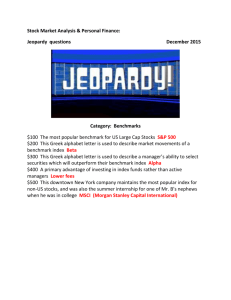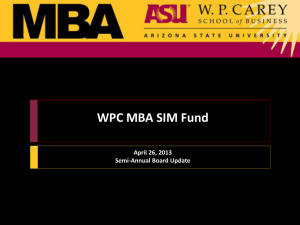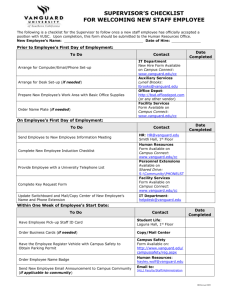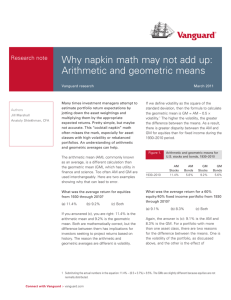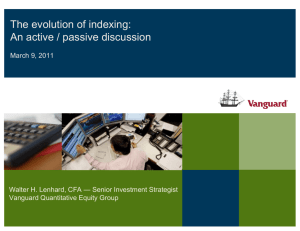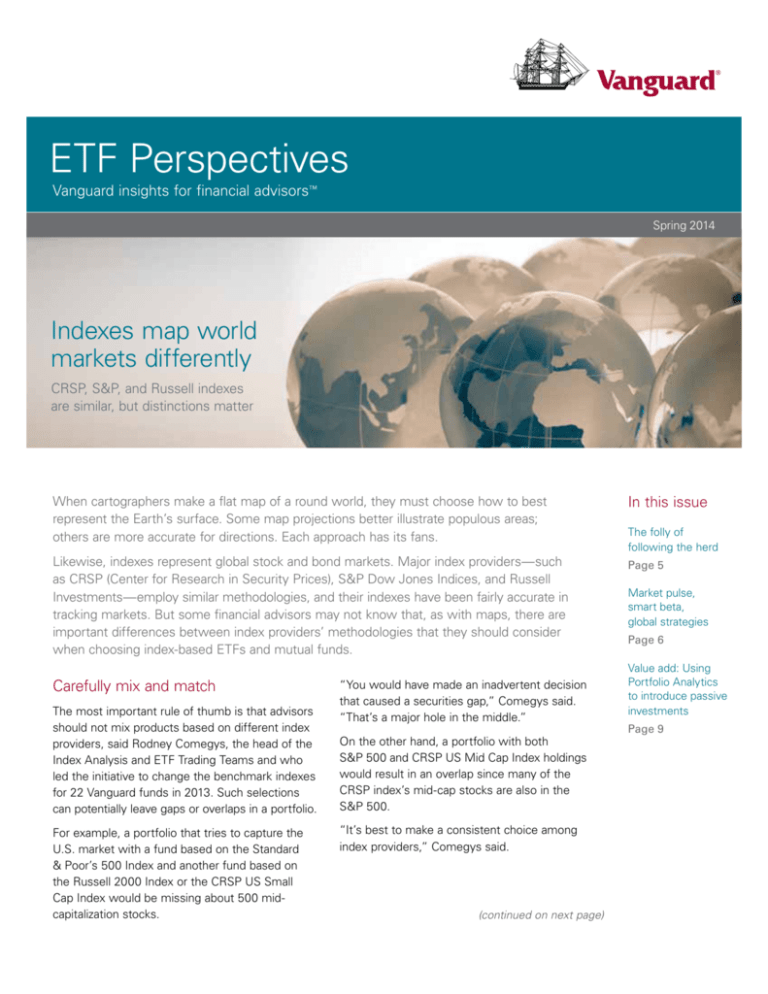
ETF Perspectives
Vanguard insights for financial advisors™
Spring 2014
Indexes map world
markets differently
CRSP, S&P, and Russell indexes
are similar, but distinctions matter
When cartographers make a flat map of a round world, they must choose how to best
represent the Earth’s surface. Some map projections better illustrate populous areas;
others are more accurate for directions. Each approach has its fans.
In this issue
Likewise, indexes represent global stock and bond markets. Major index providers—such
as CRSP (Center for Research in Security Prices), S&P Dow Jones Indices, and Russell
Investments—employ similar methodologies, and their indexes have been fairly accurate in
tracking markets. But some financial advisors may not know that, as with maps, there are
important differences between index providers’ methodologies that they should consider
when choosing index-based ETFs and mutual funds.
Page 5
Carefully mix and match
The most important rule of thumb is that advisors
should not mix products based on different index
providers, said Rodney Comegys, the head of the
Index Analysis and ETF Trading Teams and who
led the initiative to change the benchmark indexes
for 22 Vanguard funds in 2013. Such selections
can potentially leave gaps or overlaps in a portfolio.
For example, a portfolio that tries to capture the
U.S. market with a fund based on the Standard
& Poor’s 500 Index and another fund based on
the Russell 2000 Index or the CRSP US Small
Cap Index would be missing about 500 midcapitalization stocks.
“You would have made an inadvertent decision
that caused a securities gap,” Comegys said.
“That’s a major hole in the middle.”
On the other hand, a portfolio with both
S&P 500 and CRSP US Mid Cap Index holdings
would result in an overlap since many of the
CRSP index’s mid-cap stocks are also in the
S&P 500.
“It’s best to make a consistent choice among
index providers,” Comegys said.
(continued on next page)
The folly of
following the herd
Market pulse,
smart beta,
global strategies
Page 6
Value add: Using
Portfolio Analytics
to introduce passive
investments
Page 9
Indexes map world markets differently (continued)
CRSP Targets market-cap percentages
CRSP US
Total
Market
Index
Target:
100%
market
cap
S&P
Targets number of stocks
CRSP US
Large Cap
Index
CRSP US
Mega Cap
Index
S&P Total
Market
Index
85%
653
71%
295
Result:
100%+
market
cap
Result:
3,618
stocks
15%
369
S&P 500
Index
Target:
500
stocks
Result:
80%
market
cap
CRSP US
Mid Cap
Index
CRSP US
Small Cap
Index
Russell
3000
Index
Russell
1000
Index
Russell
Top 200
Index
Target:
3,017
stocks
1,104
91%
195
63%
Result:
99%
market
cap
S&P
MidCap
400 Index
399, 7%
13%
1,430
Russell Targets number of stocks
600, 3%
S&P
SmallCap
600 Index
Russell
Midcap
Index
819
S&P
Completion
Index
28%
2,003, 8%
3,309, 19%
Russell
2000 Index
1,526, 2%
Russell
2500
Index
2,522, 18%
Russell Microcap
Index
Sources: CRSP, Russell, and S&P. Note: CRSP, Russell, and S&P market-capitalization ranges calculated by FactSet as of December 31, 2013.
Investment beliefs
The easiest way to avoid gaps or overlaps is to
choose a product that covers the majority of the
U.S. stock market, such as the CRSP US Total
Market Index. With more than 3,600 securities
as of January 31, 2014, this index includes 99.5%
of U.S. equities by market cap, Comegys said.
But advisors often use multiple products to
capture the market, usually for tactical asset
allocation or tax-harvesting reasons. In the
latter case, advisors can sell losing positions
to offset capital gains elsewhere in portfolios.
The most basic decision for such advisors is
whether to cover the U.S. equity market with
three funds—mega-, mid-, and small-cap—or
simply with a large- and a small-cap fund,
Comegys said.
Sometimes, advisors choose products to
express investment beliefs, such as a conviction
that small-cap value or dividend-paying stocks
will outperform over time.
2
When choosing products based on the various
indexes, advisors should be aware of how the
indexes are put together and what sections of
the market they represent.
This is not as much of a choice based on quality
as it was 12 years ago, when former Vanguard
Chief Investment Officer Gus Sauter wrote a
seminal article in the Journal of Indexes1 that
outlined what became the best practices in
the industry.
Now, most larger index providers follow such
principles. They include using float-adjusted
indexes (that is, indexes that include only
shares available to the general public), providing
objective definitions for value and growth stocks
as well as for large- and small-cap stocks, and
defining market capitalization with bands so
stocks can drift gradually from small- to
large-cap status.
1 Sauter, Gus, 2002. Index Rex: The Ideal Index Construction.
Journal of Indexes, 2d. quarter.
“There’s been convergence around basic
procedures. Indexes are more equal, more
commoditylike these days,” said Walter Lenhard,
a senior investment analyst in Vanguard
Equity Investment Group.
As a result, CRSP is thorough in using
proportional, float-adjusted market-cap
weighting. CRSP also distinctly delineates
across the value-growth spectrum,
Comegys said.
Nonetheless, some variations are notable.
S&P, for instance, uses a committee system,
along with a set of rules, to choose stocks in its
ubiquitous S&P 500 Index. One rule employed
by S&P is the requirement that a company be
profitable for a year after it goes public. For
instance, Facebook was not added to the index
until 19 months after its initial public offering.
“What advisors like about CRSP methodology
is that there tends to be more of a pure break;
there’s not a lot of stocks that sit in the middle,”
Comegys said. “CRSP makes a determination
that a security is either value or growth. The only
time it lies in between is when it’s moving across.
There’s a little more purity. S&P and Russell have
techniques that, if a stock is hard to define, they
split parts of it in both.”
“The committee structure can be viewed as
subjective,” Comegys said. “Committees don’t
have computers or models decide. They have
humans do it, and they do a good job.”
Where providers draw the lines
The S&P 500, S&P MidCap 400, and S&P
SmallCap 600 Indexes together still leave out
about 10% of the U.S. stock market, by market
cap. But the S&P Completion Index, which
Vanguard Extended Market Index Fund seeks
to track, complements the S&P 500, so the
two combined provide full market coverage.
Russell’s indexes capture the entire market,
but Russell makes a sharp division between
large- and small-cap stocks. Each June, Russell
ranks stocks based on market capitalization.
The Russell 1000 Index encompasses the top
1,000 stocks in the broad-market Russell 3000
Index, while the Russell 2000 Index captures
the other 2,000, which include even
micro-cap stocks.
Yet between value and growth stocks, both
S&P and Russell provide a middle ground for
issues that do not fit neatly into either category.
CRSP, based at the University of Chicago, is
a relatively new index provider. But Comegys
said CRSP had the benefit of using its ample
library of historical stock data and the practices
of other index providers to help undergird its
methodology.
“
The committee structure
can be viewed as subjective.
Committees don’t have
computers or models decide.
They have humans do it,
and they do a good job.
”
—Rodney Comegys
Nonetheless, Vanguard research has shown
that there is no empirical evidence that any
ETF or fund based on a particular index provider
will outperform over time (Determining the
appropriate benchmark: A review of major
market indexes, Philips and Kinniry, 2012).
Therefore, advisors who want to make tactical
allocations in clients’ portfolios should feel free
to decide which product best fits their needs.
“That’s why we’ve gone to an unbridled multiple
benchmark lineup,” Lenhard said. “We offer
widely used U.S. equity indexes—Russell, S&P,
CRSP—and let the advisor decide.”
(continued on next page)
3
Indexes map world markets differently (continued)
Equity methodology for major U.S. index providers
S&P
Russell
CRSP
Weighting
methodology
Float-adjusted market
capitalization.
Full market capitalization,
adjusted for free float
only after inclusion in
index.
Float-adjusted market
capitalization.
Construction
methodology
Based on criteria
established by
S&P committee.
Rules-based.
Rules-based.
Rebalancing
methodology
Changes made on
as-needed basis.
No annual or semiannual
reconstitution.
Annual rebalancing
in June, subject to
capitalization banding
(+/– 2.5%) as of 2007.
Quarterly rebalancing,
with security migration
subject to “packeting.”1
Securities
makeup
Securities that reflect the
U.S. equity markets and,
through the markets, the
U.S. economy.
Publicly traded
companies in the United
States with market caps
greater than $30 million.
U.S. equities traded
on NYSE, Nasdaq, or
NYSE Arca.
Growth criteria
Trailing three-year
earnings per share (EPS)
growth.
•
I/B/E/S forecast
medium-term growth
(two years).
•
onsensus long-term
C
growth forecast from
I/B/E/S.
•
ales per share
S
historical growth
(five years).
•
onsensus one-year
C
forecast from I/B/E/S.
•
hree-year growth
T
in EPS.
•
hree-year growth
T
in sales per share.
•
urrent investmentC
to-assets ratio.
•
Return on assets.
•
Book/price ratio.
•
PS consensus
E
forecast one year
ahead divided by
stock price.
•
ost recent EPS
M
divided by stock price.
•
Dividend/price ratio.
•
Sales/price ratio.
Value criteria
Growth and
value crossover
4
•
hree-year sales
T
growth.
•
omentum—
M
12-month percentage
price change.
•
Price/book ratio.
•
Price/earnings ratio.
•
Price/sales ratio.
Style indexes—limited
overlap between growth
and value indexes.
Pure style indexes—
stocks placed in either
growth or value index.
•
Price/book ratio.
Securities may be
classified proportionately
in both growth and value
indexes.
Securities may be
classified proportionately
in both growth and value
indexes.
1 CRSP’s methodology introduces the concept of “packeting,” which cushions movements between adjacent indexes and allows holdings to be shared
between two indexes of the same family. At reconstitution, if a company has moved significantly through a breakpoint to the core of an adjacent index,
a packet of 50% of the total holdings of the company is moved between the indexes. The objective is to maximize style purity and minimize turnover.
FROM THE ETF CAPITAL MARKETS DESK
The folly of following the herd
Timing the market is a tricky—and mostly fruitless—pursuit. That’s why Vanguard
stresses the importance of staying the course. That approach also makes sense from
a trading perspective.
Brandon Clark is head of
the ETF Capital Markets
Team at Vanguard.
His team works
with Vanguard sales
executives to help
advisors obtain best
execution on large orders.
The team also works
with market makers to
ensure they understand
Vanguard ETFs ®.
One of the beauties of ETFs is that they
most often trade inside the cost of trading the
underlying basket of stocks, saving investors the
cost of assembling the basket of stocks on their
own. And traders have the unique advantage
of choosing whether to trade the ETF or the
underlyings, which can save on execution costs,
assuming the order size is sufficiently large.
For example, let’s say everyone is selling smallcapitalization stocks. The choice of whether
to trade individual stocks or a small-cap ETF
is driven by cash flows into or out of the ETF.
If it’s selling at a premium, it’s better to buy
the underlyings if you are placing a sufficiently
large order. If it’s selling at a discount, it’s better
to buy the ETF. Understanding these multiple
layers of liquidity can help you adjust your trade
execution as premiums or discounts in the
ETF widen.
Many of the outlier premium/discount events
result when the herd is chasing performance,
selling out of positions that are underperforming
or reacting to short-term volatility in the financial
markets. Cash flows push the ETFs to the
boundaries of their premiums/discounts, only
to have prices revert to their historical averages
in a few days.
Advisors are often worried about getting best
execution, and they should be, but when you
are reacting with everyone else, you have to
wonder, what does best execution look like?
Staying the course can offer trading advantages
in two ways:
Rebalancing an account: If you are selling
out of your winners as everyone else is buying
them, you may receive a premium on your trade
price. If you are reallocating into an asset that is
selling off, you could receive a discounted price.
Recurring investments: While paying attention
to premiums and discounts can benefit your
clients when rebalancing, it is less important
as recurring investments are made based on a
client’s long-term strategy. Generally speaking,
the effect of market volatility tends to wash out
over the long term.
Having the fortitude to rebalance can protect
you and your clients from the folly of following
the herd and paying the herd penalty, which can
add up over time. By contrast, having a reactive
investment approach can mean getting bruised
by the stampede into or out of any asset class.
5
Market pulse, smart beta, global strategies—
Our panel answers your questions
We gathered a number of Vanguard leaders together in February to get their take on some of the questions
we most often field from advisors. On the panel were Joseph Brennan, head of Vanguard Equity Index Group;
Joel Dickson, a senior investment strategist in Vanguard Investment Strategy Group; and Gregory Davis, the new
head of Vanguard Fixed Income Group.
What did you tell clients who were concerned
that the stock market was overvalued early
this year?
Many investors have reduced or shifted their
bond exposure because of concerns over rising
interest rates. Your thoughts?
Brennan: Two things. First, we discussed how
price/earnings (P/E) ratios1 contracted for most
of the prior decade. Prices came down faster
than earnings early in the decade, and when
earnings finally stabilized, prices didn’t respond.
It wasn’t until this decade that P/E ratios finally
began to expand, meaning we’ve been in a
catch-up phase. People often wait until a stock
market recovery is obvious before they respond,
which often makes P/E contractions last longer
than is justified. In short, I’d say the market
was more fully valued than in recent years in
January, but it wasn’t in bubble territory.
Davis: Rising rates are already priced into the
market, based on the shape of the yield curve.
The question is whether rates rise more or less
than the consensus view. If an investor’s time
horizon is longer than the duration2 of his or her
bond portfolio, the investor will benefit from
rising rates as coupon payments and principal
are reinvested at higher rates. If an investor’s
time horizon is less than the duration of the
bond investment, the investor will be worse off
because he or she won’t have time to generate
sufficient income to make up for lost principal.
Second, trying to time market cycles is a hard
way to make a living. Very few investors have
successfully timed the market at the macro
level. I counsel advisors to stick to long-term
allocations based on their clients’ risk tolerance,
needs, and time horizons. Peeling off some
equity holdings to rebalance periodically into
other asset classes is the better discipline rather
than trying to ride the market’s ebbs and flows.
‘‘
‘‘
If a client is invested in a total bond index
fund with an intermediate duration, there’s
nothing to be afraid of if the client’s horizon
is longer term.
For example, if a client is invested in a total
bond index fund with an intermediate duration,
there’s nothing to be afraid of if the client’s
horizon is longer term.
Advisors need to keep in mind the critical
role that bonds play in diversifying a portfolio,
regardless of the interest rate environment.
In the event of a stock market correction, you
want to make sure clients have a portion of
their portfolios in high-quality3 bonds to provide
some downside protection.
Dickson: When people discuss rising rates,
I often find they are thinking in terms of the
yield curve moving up in parallel fashion, as
opposed to a change in the yield curve’s shape.
Let’s say an investor moved to a shorter
duration in fear of rising rates. If rates move up
evenly along the yield curve but it takes several
years for that scenario to play out, the investor
would have given up significant income because
of the steepness of the yield curve. That could
Gregory Davis
Vanguard Fixed Income Group
6
1. A valuation ratio of a company’s current share price compared with its per-share earnings.
2. A measure of the sensitivity of the price (the value of principal) of a fixed income investment to a change in interest rates.
Duration is expressed as a number of years. Rising interest rates mean falling bond prices, while declining interest rates mean rising bond prices.
3. A bond whose credit quality is considered to be among the highest by independent bond-rating agencies.
Interest rates, like stock prices, can move
based on unexpected information. Because we
don’t know what will happen, it’s important to
maintain exposures to U.S. Treasury, corporate,
and mortgage-backed securities. They all can
help with the range of scenarios that can occur.
Do you think factor-based indexing and
smart beta 4 have changed the conversation
around indexing?
Brennan: There have always been investment
fads, and there always will be as long as
investment managers compete for dollars.
Marketing takes pure investment ideas,
repackages them, and tries to get people to
buy them. What some providers are calling
indexing we consider active management.
Any time you invest in a way that deviates
from what the market has priced in using
market capitalization—that’s an active tilt.
It’s not bad or evil; it’s just not indexing.
Our main caution to investors in these
products is to pay attention to price and to
methodology. Know what you are buying.
Dickson: The development and growth of
ETFs have blurred the lines between active
and passive. Indexing has expanded to include
the tracking of indexes that represent rulesbased active management strategies. What we
have seen is an evolution of what people seek
to track in terms of indexes and how people are
using index-tracking funds in portfolio strategies.
The main concern with alternatively weighted
indexes is that investors are giving up control
and consistency in their exposures, often at
a higher cost than could be achieved through
similar exposures in market-cap-weighted
index vehicles.
Has the popularity of alternative indexes
complicated the rules of portfolio construction?
Brennan: Advisors combine these different
exposures because they are seeking to pull
out volatility and return streams that might not
be correlated with each other or the rest of the
portfolio. One problem with the due diligence on
these products is that you need historical returns
and volatility to mock up the history; however,
there isn’t much history on these products and
much of the “history” is based on hypothetical data.
Second, advisors using a core-satellite structure
should not consider an alternative index product
as a replacement for the core investment.
Alternative indexes have the components of
a satellite (concentrated beta, future alpha5
opportunity, volatility reduction), not of a core,
investment. We don’t see them as an alternative
to indexing. We don’t even see them as indexing.
‘‘
‘‘
be a significant opportunity cost. Alternatively,
if short rates go up more than anticipated,
the investor actually would have done better
to remain at the long end of the yield curve.
Marketing takes pure investment ideas,
repackages them, and tries to get people
to buy them.
Joseph Brennan
Vanguard Equity Index Group
Dickson: A lot of what we’re seeing in ETFs
today is the same as what we saw in the mutual
fund industry 25 years ago, when investment
managers and advisors were creating mutual fund
wrap programs and wirehouses were building
model portfolios of traditional mutual funds.
We suggest that advisors considering adding
fundamental indexes look at how the addition fits
into their overall strategy. There are tools that can
help you assess the total risks in the portfolio,
which is more important than selecting individual
ETFs based on a case-by-case approach.
(continued on next page)
4. A measure of the magnitude of a portfolio’s past share-price fluctuations in relation to the ups and downs of the overall market (or appropriate market index).
5. A
measure of performance on a risk-adjusted basis. Alpha takes the volatility (price risk) of a mutual fund or ETF and compares its risk-adjusted performance with that of a benchmark index.
The excess return of a fund relative to the return of the benchmark index is the fund’s alpha.
7
Market pulse, smart beta, global strategies—
Our panel answers your questions (continued)
‘‘
‘‘
I’m encouraged by how investors responded to last
year’s market surge. I remember when the question
would always be “Why didn’t I make 32%?” if the
S&P 500 Index was up 32%.
Joel Dickson
Vanguard Investment
Strategy Group
Vanguard transitioned 22 funds and their ETF
Shares, if they had any, to new indexes last year.
How did that go?
Brennan: All the transitions went incredibly
well. We believe, based on many comments
from the Street, that they were fairly undetected
in the marketplace, which was the goal. It was
a credit to our management teams that they
chose venues where we could transact without
disadvantaging our clients.
Joe, you spent four years in Australia as chief
investment officer of the Asia Pacific region
and a director of Vanguard Investments Australia.
Any take-aways for advisors from this period?
Brennan: I was struck by how far global investing
has come for all investors. People still have a
home-country bias, but individual investors,
advisors, and institutional asset managers have
all become much more global in their thoughts
and processes. It helps that the cost of investing
globally has come down as the number of
competitors, including Vanguard, has increased.
Investors have their own unique way of thinking
about things, but at the end of the day, they are
always interested in better advice and lower
prices. I think Vanguard has had a strong entry
into Canada, the United Kingdom, and Asia
because we have worked well with advisors
who are delivering on those essentials.
Greg, you took over Joe’s role in Australia before
moving back to Pennsylvania. Any additional
observations?
8
Davis: I’ve seen a prevalence of home bias in
Australia and Asia. But all investors face the
same challenge of how to generate additional
yield. What we tell U.S. advisors applies equally
in Australia: Understand your clients’ goals and
risk tolerance, construct low-cost diversified
portfolios, and take the long-term view. As part
of that, we’ve been encouraging greater adoption
of international exposures on both the equity
and the bond sides and, specifically, a currencyhedged6 approach to international bond indexing.
You recently took over from Vanguard legend
Bob Auwaerter. Any changes afoot?
Davis: No. He assembled a very talented
group with tremendous experience on the
research side, the portfolio management team,
and the trading side. We have investment
processes on the index and active sides that
have performed extremely well, so there’s
no need for significant change.
Is there any advantage to indexing your
international bond exposure, rather than
having it actively managed?
Davis: The return distribution is much smaller
for bonds compared with equities, and this
is especially true in a low-yield environment.
The drag of turnover and transaction costs is
therefore more acute, especially when dealing
with less liquid corporate and emerging market
issues. We feel that active managers have a
high hurdle to overcome in international bond
markets, while an index product provides broad
diversification across all sectors at a lower cost.
Are investors more realistic about future
market returns?
Dickson: I’m encouraged by how investors
responded to last year’s market surge.
I remember when the question would always
be “Why didn’t I make 32%?” if the S&P 500
Index was up 32%. Now investors accept the
value of having bonds and emerging markets
in their portfolios—and that means the full
portfolio won’t necessarily produce the return
of the better-performing asset class each year.
6. Currency hedging risk is the chance that currency hedging transactions
may not perfectly offset a fund’s foreign currency exposures and may
eliminate any chance for the fund to benefit from favorable fluctuations
in those currencies.
Value add: Using Portfolio Analytics
to introduce passive investments
Storytellers use many tools to convince their “clients”—that is, their listeners or readers—to view the world in
a different way than they had previously. One such tool familiar to most of us is the old saw, show, don’t tell.
When it comes to explaining abstract investing strategies to clients, the storyteller’s axiom might be equally
helpful advice for financial advisors. For instance, what better way to convey to a client the advantages of
adding passive holdings to a portfolio than to create a model—and to let the client see the potential results—
before committing?
The advantages of reducing active management
risk by adding passive investments are wellknown (see the Vanguard white paper Enhanced
practice management: The case for combining
active and passive strategies, Philips, Kinniry,
and Schlanger, 2012):
•
Reduced volatility relative to the market.
•
eduction of costs and potentially increased
R
tax efficiency of the portfolio.
•
itigation of the significant underperformance
M
that historically has resulted from active
management.
Intellectually, this makes sense. But how
does an advisor illustrate the idea to clients
convincingly, especially when choppy portfolio
performance brought on by volatile markets
may lead clients to question their advisors’
strategy?
The Portfolio Analytics tool from Vanguard,
launched this past winter, offers one datadriven, visually compelling approach to help
advisors better tell their investing-strategy story.
In creating the tool, Vanguard called upon
Morningstar, Inc., to provide the tool’s
comprehensive investment-portfolio data
and metrics.
Kevin Loffredi, vice president of Integrated Web
Tools for Morningstar, said, “The tool offers
advisors a beautiful, robust, and streamlined
interface that provides a detailed view of an
investor’s current and proposed portfolios.”
The Portfolio Analytics tool main screen allows a user to enter
up to 50 products per portfolio
Advisors weigh in
In developing the tool, we went straight to
advisors to find out what they wanted most
in analytics software. Among their responses:
ease of use, versatility, and customization.
Advisors also shared what they’d rather
do without: being constrained to use one
company’s proprietary financial products,
limited functionality that makes it necessary
to use multiple programs, and tools with a
learning curve so intimidating that much of
their capability goes unused.
(continued on next page)
9
Value add: Using Portfolio Analytics to
introduce passive investments (continued)
Adding passive funds, simplified
The tool can help
an advisor identify
portfolio gaps,
evaluate risk,
and more.
Adding passive holdings is simple:
Copy the existing portfolio; type in
the new, passive holdings; and
adjust the weightings accordingly.
After conducting extensive research,
development, and, finally, testing, in the
first quarter we unveiled our response to
the advisors’ feedback. The Portfolio Analytics
tool is both simple to use and brimming with
powerful features.
The tool’s developers designed it to deal with
common situations advisors face. For instance,
advisors are typically working with portfolios
that have already been built. It’s a simple matter
to type in an existing portfolio (with up to 50
holdings), run an analysis, and, if desired, save
that analysis for later use.
It’s also easy to modify a portfolio and view
the differences in how it would have performed
before and after the changes. Regarding the
example of adding passive investments, some
advisors would like to do just that with their
clients’ portfolios but aren’t sure where or how
to start. The tool provides a springboard by
letting users compare the performance of an
actively managed portfolio side by side with that
of a portfolio that includes passive investments.
10
The click of a button delivers
a near-instant, at-a-glance
comparison of the original
and modified portfolios.
Saving advisors time
“As an advisor, one challenge is to find tools that
help me save time in conducting research and
add value to our clients,” said Steven A. Gattuso,
a senior portfolio manager with Courier Capital
Corporation in Buffalo, New York. Gattuso said
Portfolio Analytics helps him on both fronts.
“It is a great product for analyzing prospective
client portfolios, developing ‘what-if’ scenarios,
and then presenting those in a very professional
format that I can use in speaking with my
clients,” Gattuso said.
For all its outward simplicity, the tool provides
an exquisite level of detail for those advisors
who want and need deeper levels of analysis.
In analyzing two portfolios of ETFs, mutual
funds, and individual stocks side by side, the
tool provides hypothetical performance, risk
statistics, asset allocations, sector breakdowns,
weightings by world regions, and other stock and
bond characteristics (holdings-based analysis).
Produce, save, and share detailed analysis summaries
The “Generate Report” feature
lets an advisor add a cover page,
title, advisor and firm name,
as well as client name.
Advisors can easily
create reports of their
analyses for clients
and share them as
print copies or e-mail
attachments.
Compare and customize
Want to know what difference a few securities
would make in a portfolio? Curious to see what
effect adding passive investments will have on
returns? The Compare feature allows you to
test different scenarios and displays the results
side by side. A convenient Copy feature even
spares an advisor the hassle of retyping holdings
into the second portfolio.
For instance, you might begin by entering
an existing client portfolio consisting entirely
of active investments, adjusting investment
amounts and the time frame accordingly.
The tool returns information you can use
to identify portfolio gaps and evaluate risk,
among other considerations.
A number of investing assumptions, including
initial investment, rebalancing, time period,
fees, and taxes, are highly customizable.
Portfolio Analytics lets advisors tell their story
to clients in two ways. They can present the
information in client meetings by playing out
scenarios directly on the screen, or they can
present it in highly customizable, client-approved,
professional-looking PDF reports.
Gattuso offered a verdict voiced by many who’ve
used the tool so far: “It is a very comprehensive
and valuable asset already in our firm, and I
anticipate our use to increase as we find new
ways to apply it.”
It’s then a simple matter to see how,
hypothetically, that portfolio would perform
with the addition of one or more strategically
selected index funds or ETFs.
To use the Portfolio Analytics tool, go to the
Tools section of advisors.vanguard.com.
You’ll need to log in for access (registration
is free).
In addition, the tool recognizes many major
benchmarks and lets users create and save
their own custom benchmarks, all of which
they can compare with their portfolios.
Get the most out of Portfolio Analytics:
Call 800-997-2798 to contact your
Vanguard representative for a free
guided tutorial of the tool.
Note: Neither Steven A. Gattuso nor Kevin Loffredi is affiliated with Vanguard, and Vanguard does not make any representation
regarding their views.
11
Comments? Topics of interest?
Write to us at ETFPerspectives@vanguard.com
Connect with Vanguard® > advisors.vanguard.com
All investing is subject to risk, including possible loss of principal. Prices of mid- and small-cap stocks often
fluctuate more than those of large-company stocks. Funds that concentrate on a relatively narrow market sector
face the risk of higher share-price volatility.
The performance of an index is not an exact representation of any particular investment, as you cannot invest
directly in an index.
S&P® and S&P 500® are registered trademarks of Standard & Poor’s Financial Services LLC (“S&P”) and have been
licensed for use by S&P Dow Jones Indices LLC and its affiliates and sublicensed for certain purposes by Vanguard.
The [S&P 500 index] is a product of S&P Dow Jones Indices LLC and has been licensed for use by Vanguard.
Vanguard Extended Market Index Fund is not sponsored, endorsed, sold, or promoted by S&P Dow Jones Indices
LLC, Dow Jones, S&P, or their respective affiliates, and none of S&P Dow Jones Indices LLC, Dow Jones, S&P,
nor their respective affiliates makes any representation regarding the advisability of investing in such product(s).
Past performance is not a guarantee of future results.
Diversification does not ensure a profit or protect against a loss.
For more information about Vanguard ETFs, visit advisors.vanguard.com or call 800-997-2798 to obtain
a prospectus. Investment objectives, risks, charges, expenses, and other important information about
a fund are contained in the prospectus; read and consider it carefully before investing.
Tax-loss harvesting involves certain risks, including, among others, the risk that the new investment could perform
worse than the original investment, and that transaction costs could offset the tax benefit. We recommend that
you consult a tax or financial advisor about your individual situation.
Vanguard ETF Shares are not redeemable with the issuing Fund other than in Creation Unit aggregations. Instead,
investors must buy or sell Vanguard ETF Shares in the secondary market with the assistance of a stockbroker. In doing
so, the investor may incur brokerage commissions and may pay more than net asset value when buying and receive
less than net asset value when selling.
Investments in bonds are subject to interest rate, credit, and inflation risk. Although the income from the U.S. Treasury
obligations held in a fund is subject to federal income tax, some or all of that income may be exempt from state and
local taxes. Investments in stocks issued by non-U.S. companies are subject to risks including country/regional risk
and currency risk.
Vanguard Financial
Advisor Services™
P.O. Box 2900
Valley Forge, PA 19482-2900
© 2014 The Vanguard Group, Inc.
All rights reserved.
Vanguard Marketing Corporation, Distributor.
U.S. Patent Nos. 6,879,964; 7,337,138; 7,720,749;
7,925,573; 8,090,646; and 8,417,623.
FAETFPSP 042014

